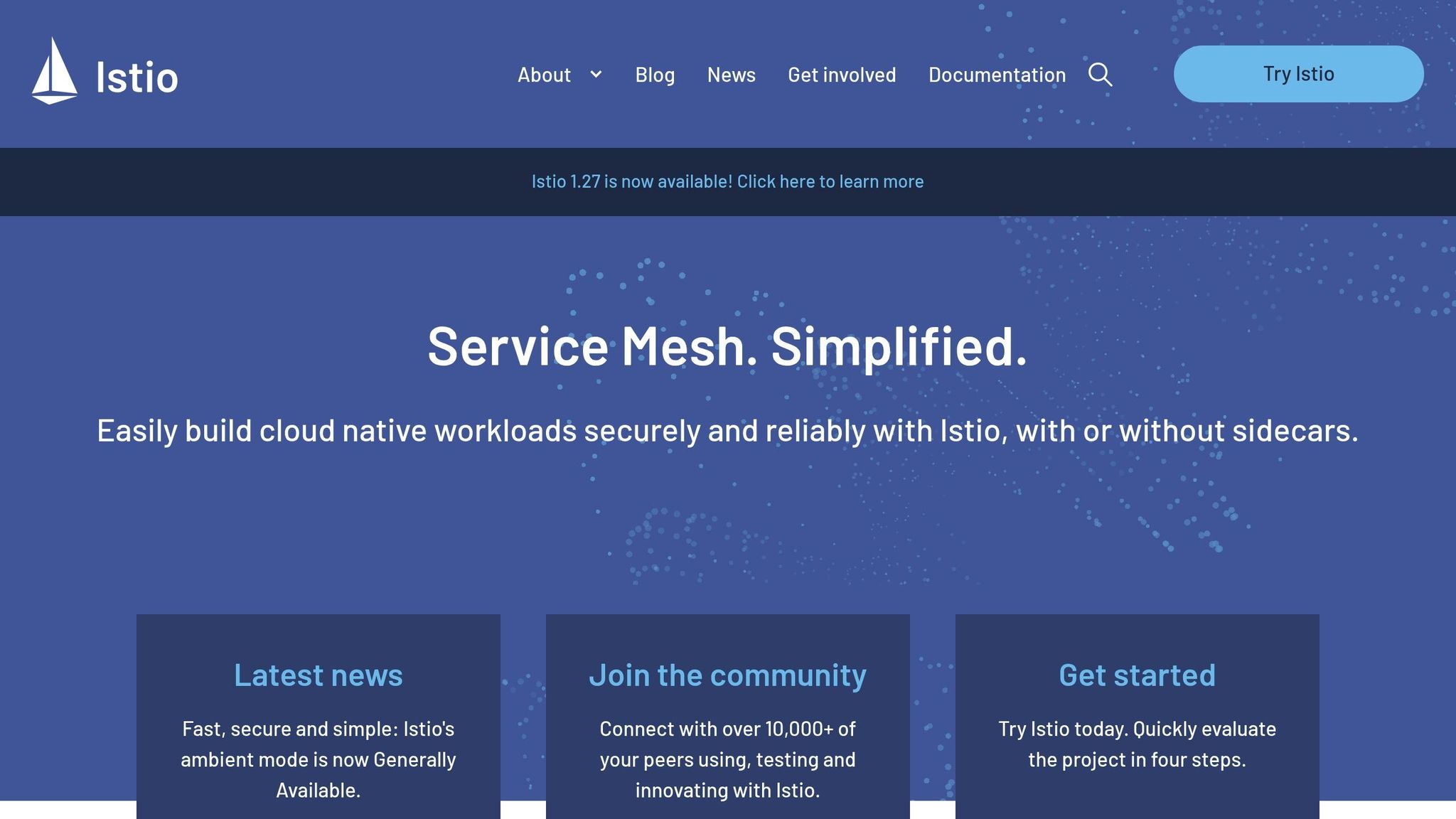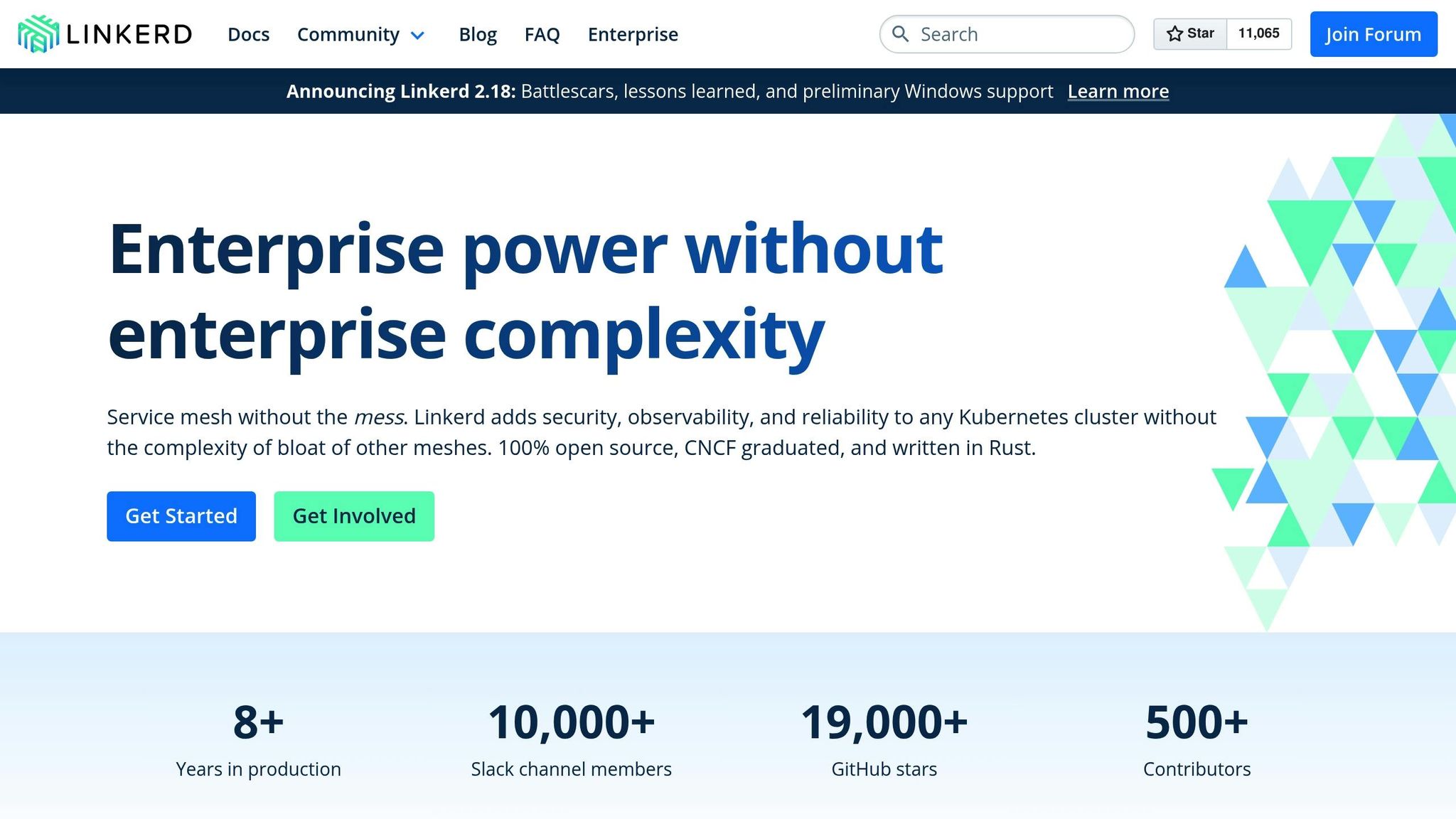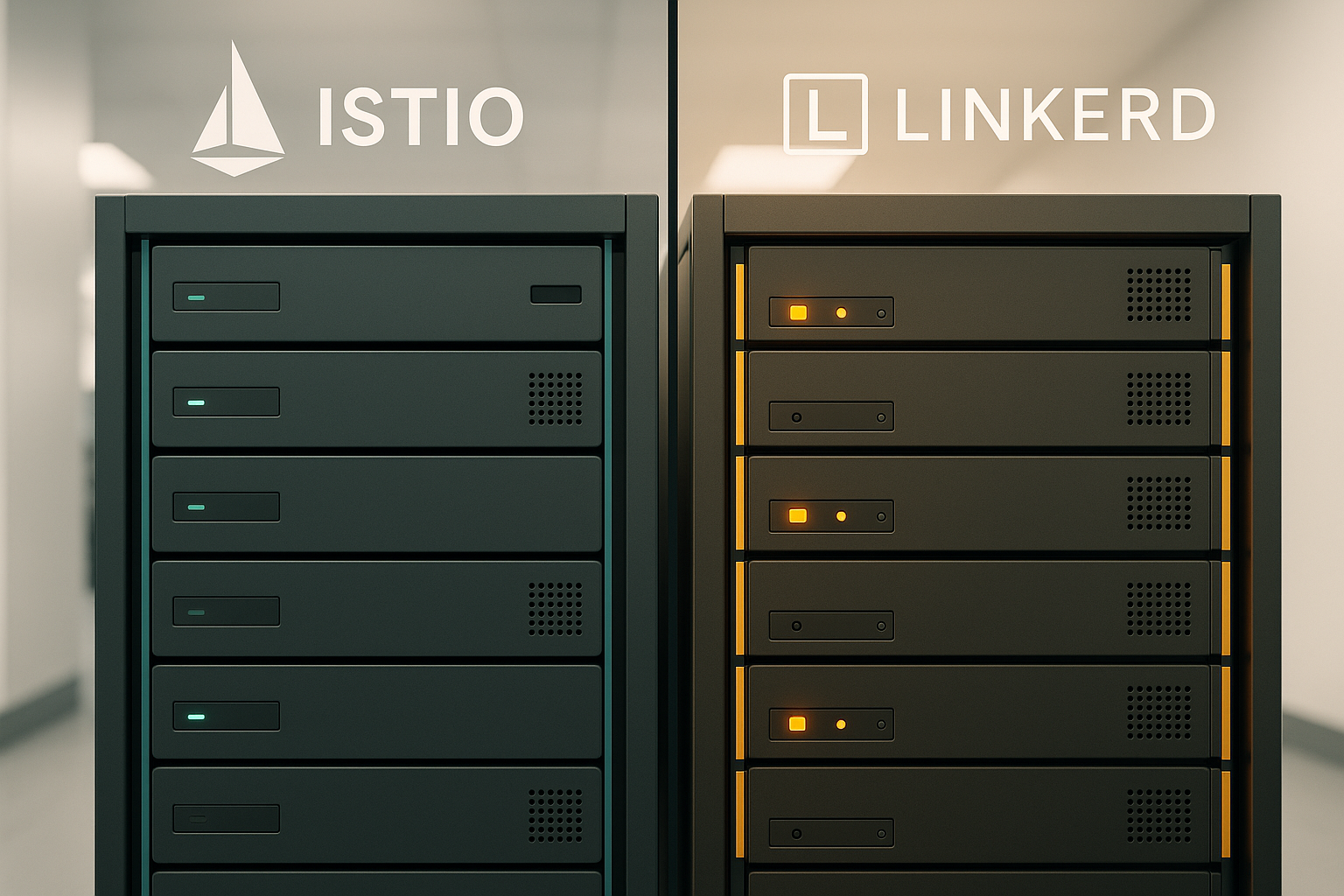Choosing between Istio and Linkerd depends on your priorities: features or cost efficiency.
Istio delivers advanced features like detailed traffic management and security, but it requires more CPU and memory, increasing cloud costs. Linkerd focuses on simplicity, using fewer resources while covering core service mesh needs.
Key Points:
- Istio: Feature-rich, better for large-scale or complex setups, but resource-intensive and harder to manage.
- Linkerd: Lightweight, easier to deploy, and cost-effective, but lacks advanced features.
Quick Comparison:
| Feature | Istio | Linkerd |
|---|---|---|
| Memory Usage | High | Low |
| CPU Overhead | High | Low |
| Setup Complexity | Complex | Simple |
| Traffic Management | Advanced (e.g., canary releases) | Basic (e.g., load balancing) |
| Security | Advanced (detailed controls) | Automatic mTLS encryption |
| Best For | Large, complex deployments | Cost-conscious, smaller teams |
If you're scaling a multi-cluster environment or need advanced observability, Istio might be worth the cost. For smaller teams prioritising efficiency and lower expenses, Linkerd is a better fit.
Istio: Architecture, Features, and Resource Usage

Istio's Architecture: A Closer Look
Istio relies on a sidecar pattern to manage communication within Kubernetes. Essentially, each application pod includes an additional container running an Envoy proxy. This proxy intercepts and controls all network traffic flowing to and from the service.
The architecture is divided into two main planes: the control plane and the data plane. The control plane functions as the system's brain, responsible for managing traffic, security, and configuration. Key components include:
- Pilot: Handles traffic management.
- Citadel: Manages security features.
- Galley: Validates configurations.
On the other hand, the data plane is made up of Envoy proxies that manage traffic routing and enforce policies. Istio integrates seamlessly with every service in the mesh by automatically injecting these sidecar proxies into application pods. With this foundation in mind, let’s explore the features that shape Istio's resource demands.
What Istio Brings to the Table
Istio supports advanced traffic routing techniques like canary releases and A/B testing, all without requiring changes to your application code. It also enhances security by encrypting service communication with mTLS, enabling a zero-trust model with detailed control over service interactions.
In addition, Istio offers robust policy enforcement. This includes capabilities like rate limiting, access controls, and the ability to implement custom business rules across the service mesh. However, these powerful features come with resource costs, as explained below.
Resource Usage and Cost Considerations
The breadth of Istio's features does come at a price - higher CPU and memory usage. Each sidecar proxy deployed alongside an application pod consumes its own share of compute and memory resources. Beyond that, the control plane components also require resources, and their demands grow as your service mesh expands.
This resource consumption can significantly influence cloud costs, especially when deploying Istio at scale. For those focused on cloud cost optimisation, it's important to weigh these trade-offs against leaner alternatives.
Linkerd vs. Istio (Rust vs. C++) performance benchmark (2023)

Linkerd: Architecture, Features, and Resource Usage
Compared to Istio's intricate design, Linkerd stands out with its simpler, more efficient approach to service mesh technology.
Linkerd's Architecture: A Minimalist Approach
Linkerd takes a no-frills approach to service mesh architecture, focusing on simplicity and performance. Its proxies are written in Rust, a programming language celebrated for its memory safety and high performance. The platform uses a pared-down control plane that handles only the essentials: service discovery, certificate management, and basic configuration. This design reduces resource demands and minimises potential points of failure.
One of Linkerd's standout features is its use of micro-proxies. These lightweight, Rust-based proxies not only consume fewer resources but also start up quickly, making them a practical choice for environments with high service-to-service communication needs.
Key Features of Linkerd
Linkerd provides all the fundamental functionalities of a service mesh without unnecessary complexity. It automatically enables mutual TLS (mTLS) encryption, ensuring secure service communication without requiring manual intervention for certificate management. Observability is another strength, with built-in metrics accessible through a user-friendly web dashboard.
When it comes to traffic management, Linkerd covers the basics, including load balancing, retry policies, and circuit breaking. While it may lack some advanced traffic-splitting capabilities found in more complex service meshes, it handles essential routing tasks effectively. Its zero-configuration deployment allows services to gain immediate benefits in security and observability, which reduces operational overhead and simplifies adoption.
This straightforward design not only makes deployment faster but also keeps operational costs lower, making it an attractive choice for teams prioritising efficiency.
Resource Usage and Cloud Costs
Linkerd's lightweight design translates directly into lower cloud infrastructure expenses. Its Rust-based proxies and streamlined control plane are optimised for minimal CPU and memory usage, which can lead to substantial cost savings, especially in environments with heavy service-to-service communication.
This efficiency makes Linkerd particularly valuable for organisations looking to manage cloud spending more effectively. Its predictable resource usage simplifies cost forecasting and allows businesses to stay within tight budgets. For teams new to service mesh technology or those with limited resources, Linkerd's low overhead and ease of deployment make it an accessible and cost-effective option for achieving a functional and efficient service mesh setup.
Need help optimizing your cloud costs?
Get expert advice on how to reduce your cloud expenses without sacrificing performance.
Cost and Resource Efficiency: Comparing Istio and Linkerd
Istio and Linkerd offer distinct approaches when it comes to features, resource demands, and the resulting impact on cloud costs. Below, we’ll explore how these differences shape their efficiency in terms of resources and expenses.
Comparison Overview: Istio vs Linkerd
- Memory Usage: Istio’s proxies consume more memory, while Linkerd’s lightweight design keeps memory usage minimal.
- CPU Overhead: Istio’s extensive features lead to higher CPU consumption compared to Linkerd’s more streamlined architecture.
- Latency Impact: Both service meshes introduce some latency, but Linkerd is built to minimise delays as much as possible.
- Control Plane: Istio’s control plane consists of multiple, resource-heavy components, whereas Linkerd consolidates these functions to reduce resource demands.
- Storage and Management Complexity: Istio requires more storage and has a steeper learning curve, while Linkerd’s simpler design makes it easier to manage.
- Cloud Cost Implications: Feature-heavy meshes like Istio can drive up infrastructure costs, especially at scale, while lightweight solutions like Linkerd help keep expenses under control.
Resource Efficiency and Cloud Savings
The resource consumption of each service mesh directly affects cloud costs. Higher memory and CPU usage can force organisations to opt for larger, more expensive cloud instances. On the other hand, a leaner architecture, like Linkerd’s, allows for more efficient scaling and lower operational costs.
Complex service meshes often demand specialised training or additional support, adding to indirect costs. Simpler solutions, however, are often easier for existing teams to manage, reducing the need for extra expertise. Additionally, streamlined deployment processes can save time and effort, which is especially valuable for organisations with limited DevOps resources.
For those looking to optimise their deployments, expert advice can make all the difference. Companies like Hokstad Consulting specialise in cloud cost engineering, offering guidance to help organisations reduce infrastructure expenses through strategic, well-planned deployments.
Use Cases and Recommendations
When to Choose Istio
Istio is a strong choice for managing complex, large-scale deployments that demand advanced traffic control, detailed monitoring, and stringent security measures. Organisations operating hundreds of services across multiple clusters can take advantage of Istio's powerful routing capabilities, in-depth observability tools, and precise access controls.
Industries like financial services, which are heavily regulated, often require extensive compliance features and audit trails. In these cases, Istio's advanced security options justify its higher resource requirements. Its ability to enforce strict policies and monitor traffic in detail makes it an excellent fit for meeting regulatory demands.
Teams with experienced platform engineers are well-suited to leverage Istio's capabilities. Its complexity means it requires skilled professionals to configure and manage the mesh effectively. For organisations with the right expertise, Istio offers significant benefits for mission-critical applications.
Multi-cloud environments also gain from Istio's robust feature set. When services operate across different cloud providers or hybrid infrastructures, Istio ensures consistent traffic management and security, helping to unify diverse systems.
When to Choose Linkerd
While Istio excels in intricate environments, Linkerd shines in scenarios where simplicity and cost-efficiency are key. It's ideal for smaller or mid-sized teams that need essential service mesh features without the burden of high operational overhead. Development teams focused on quick deployment cycles appreciate Linkerd's easy setup and minimal maintenance.
For organisations mindful of costs, Linkerd is an attractive option. Its lower resource requirements can significantly reduce cloud expenses, making it particularly appealing to startups or businesses with limited budgets. Teams can achieve core service mesh functionality while keeping infrastructure costs under control.
Linkerd also integrates seamlessly with Kubernetes-native setups. Organisations already relying on Kubernetes tools and workflows will find that Linkerd fits neatly into their existing environment without requiring major changes or steep learning curves.
When simplicity is more important than an extensive feature set, Linkerd is an excellent choice. For teams needing basic service communication, observability, and security, its streamlined design reduces complexity while delivering the essentials.
Expert Guidance for Optimisation
Choosing the right service mesh requires careful consideration of both current and future needs, as well as alignment with team expertise and budget constraints.
Expert advice can help avoid costly mistakes. Hokstad Consulting, for instance, specialises in cloud cost engineering and DevOps strategies, guiding businesses through the decision-making process. They ensure organisations select solutions that meet technical requirements while staying within financial limits.
Implementation is just as critical as the choice of platform. Expert guidance can prevent common issues, such as over-provisioning resources for Istio or underestimating Linkerd's limitations in more demanding scenarios. With proper planning, businesses can optimise long-term costs and improve team efficiency.
Services like Hokstad Consulting's no savings, no fee
model eliminate financial risk. This approach ensures that the chosen service mesh delivers measurable cost benefits before any fees are charged, making it a low-risk path to optimisation and efficiency.
Conclusion
Deciding between Istio and Linkerd comes down to balancing your organisation's feature requirements with the complexity and costs involved. Istio is ideal for enterprises that need robust traffic management, advanced security, and in-depth observability across large-scale, multi-cluster environments. However, these advanced capabilities come with higher resource demands and increased operational effort.
On the other hand, Linkerd offers a straightforward and cost-effective solution. Its lightweight design provides essential service mesh features while helping to keep infrastructure expenses under control. This can be particularly appealing for UK businesses operating within tighter budgets or those just starting to implement a service mesh. The choice ultimately depends on carefully evaluating trade-offs between cost and performance.
It's also essential to consider the broader financial picture, which goes beyond initial deployment costs. Factors like resource usage, operational complexity, and the expertise required to manage the platform all play a role. Seeking guidance from experts, such as Hokstad Consulting, can help you make informed decisions. They can assist in aligning your technical needs with your budget and ensuring the platform you choose supports both your current goals and future growth.
FAQs
What are the cost and resource efficiency differences between Istio and Linkerd?
Linkerd stands out as a more cost-effective option compared to Istio, largely due to its lower resource demands, especially when it comes to CPU and memory usage. Research highlights that Linkerd’s data plane consumes far fewer system resources, which can translate into noticeable savings on cloud infrastructure costs.
For organisations working within tight resource limits or aiming to cut down on cloud expenses, Linkerd’s streamlined design offers a practical solution. Its efficiency helps keep costs in check without compromising on dependable performance.
How do team size and expertise influence the choice between Istio and Linkerd?
When deciding between Istio and Linkerd, the best choice often hinges on your team’s size and expertise.
For smaller teams or those with less experience, Linkerd tends to be a go-to option. Its simplicity, ease of deployment, and lower resource demands make it an excellent fit for straightforward applications and environments.
Meanwhile, larger teams or those with more advanced technical skills might lean towards Istio. Though it’s more complex and resource-intensive, Istio provides a wider array of features and the flexibility to tackle more intricate use cases and cloud environments.
In short, Linkerd is a great match for lightweight, uncomplicated setups, while Istio works well for those ready to handle its extensive functionality.
Is Linkerd secure enough for regulated industries, or is Istio required to meet compliance standards?
When it comes to security, Linkerd stands out with its mutual TLS (mTLS), which encrypts all TCP traffic. For many scenarios, this level of security is more than adequate. However, for industries bound by strict compliance standards, Istio provides a more extensive security framework. It includes advanced features like HTTP header policy enforcement and seamless integration with external identity providers such as OAuth and SPIFFE. These capabilities are essential for organisations that need to adhere to rigorous regulatory requirements.
While Linkerd is well-suited to environments with less stringent demands, Istio's advanced security and policy management tools make it the preferred option for businesses in highly regulated sectors.
